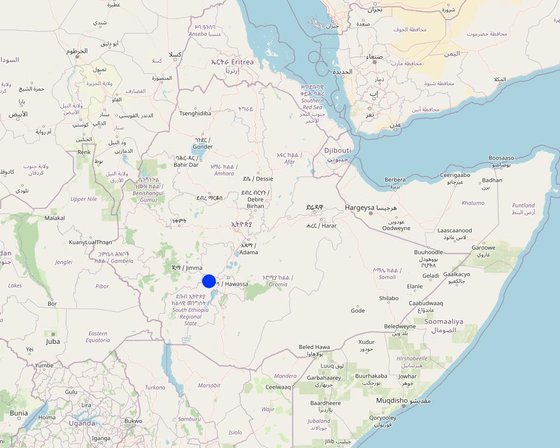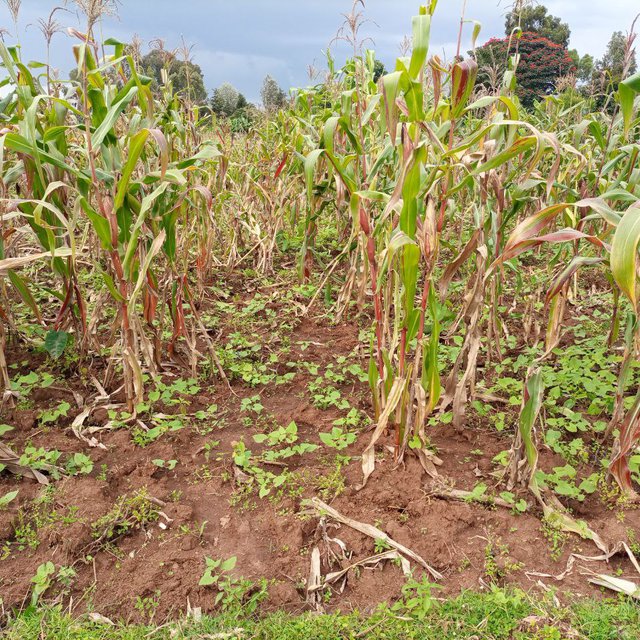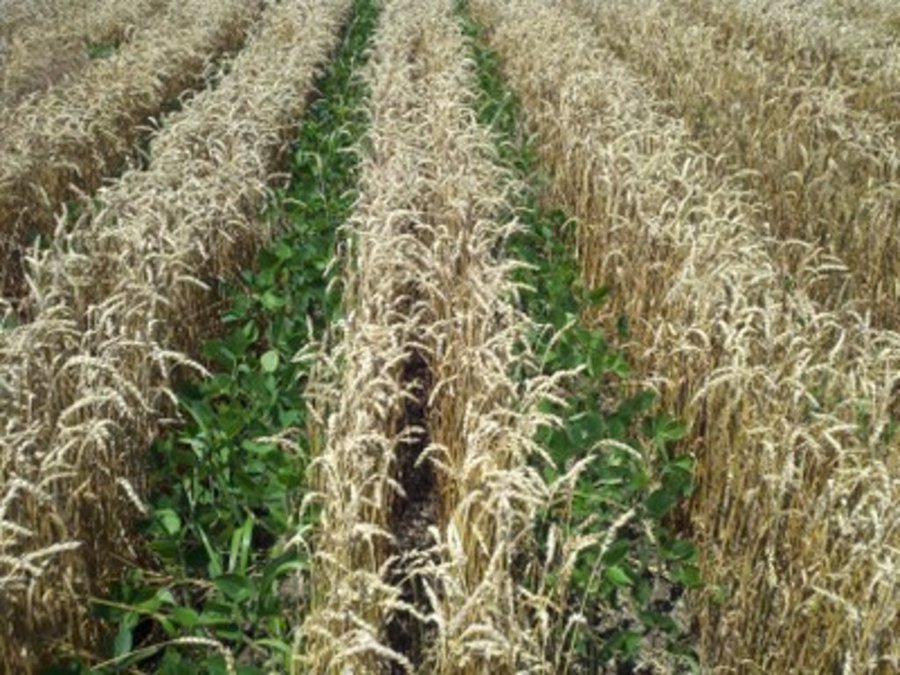Relay Intercropping
(ប្រទេសអេត្យូពី)
Kurcheta
ការពណ៌នា
Intercropping is the growing of two or more crops on the same piece of land at the same time or in temporal sequence. Relay intercropping usually involves planting a legume into an established cereal crop. This farming practice has multiple benefits and is a popular among smallholders in Wolaita zone of SNNPR.
Intercropping systems in Sodo Zuria of Waraza-Lasho kebele are characterized by relay intercropping. Under relay intercropping a second crop is planted alongside a growing crop, typically when it has reached its reproductive stage of growth. The practice enables efficient use of available space. In this kebele (lower administrative unit), field peas and haricot beans are commonly intercropped within maize. The seeds of these legumes are either sown in no particular pattern, or simply broadcast, under the main crop, maize. They are planted when the maize comes close to physiological maturity. Intercropping of cereals with legumes improves soil fertility through nitrogen fixation: this system extracts fewer nutrients from the soil than do monocrops. The practice also avoid risks of crop failure, improves effective use of available land, generates additional income and ensures food and nutrition security of the family farmers. Making the right choices about crops and timing of relay planting is crucial. Furthermore, good intercropping demands improved varieties of cereals and legumes. Adequate and timely labour is required also. Conventionally, the farmers till the land up to five times before planting the main crop. In relay intercropping further more land cultivation is essential to plant the companion crop.
Various researchers have reported considerably higher yields from intercropping compared with a pure stand. This can be measured through the “land equivalent ratio” which describes the relative land area required under sole cropping to produce the same yield as under intercropping. Intercropping has been regarded by many farmers as a technique that reduces risk in crop production. It improves carbon sequestration since it enhances biomass accumulation both above and below the surface of the soil. Intercropping is also a form of climate change adaptation strategy as it spreads risks and allows opportunistic use of extra moisture. However, relay intercropping can subject the land to compaction because the companion crops demand extra field operations. These include harvesting the main crops, or sometimes stripping the leaves to reduce the shading effects for the low growing companion crops. There is also extra labour required for weeding and harvesting of the intercrop.
ទីតាំង

ទីតាំង: Sodo Zuria, SNNPR, ប្រទេសអេត្យូពី
ចំនួនទីកន្លែងបច្ចេកទេស ដែលវិភាគ: មួយកន្លែង
ចំណុចយោងភូមិសាស្ត្រនៃទីតាំងជ្រើសរើស
ការសាយភាយនៃបច្ចេកទេស: ត្រូវបានផ្សព្វផ្សាយត្រឹមតំបន់មួយ (approx. 0.1-1 គម2)
តើស្ថិតក្នុងតំបន់ការពារអចិន្ត្រៃយ៍?: ទេ
កាលបរិច្ឆេទនៃការអនុវត្ត: ច្រើនជាង 50 ឆ្នាំមុន (ប្រពៃណី)
ប្រភេទនៃការណែនាំឱ្យអនុវត្តន៍៖
-
តាមរយៈការបង្កើតថ្មីរបស់អ្នកប្រើប្រាស់ដី
-
ជាផ្នែកនៃប្រព័ន្ធប្រពៃណី (> 50 ឆ្នាំ)
-
ពេលកំពុងពិសោធន៍
-
តាមរយៈគម្រោង / អន្តរាគមន៍ពីខាងក្រៅ
-
through agricultural extension system

Haricot beans intercropped under the main crop maize when the latter reached physiological maturity. (Abiyot Kebede)
គោលបំណងចម្បងៗ
-
ធ្វើឱ្យប្រសើរឡើងនូវផលិតកម្ម
-
កាត់បន្ថយ, បង្ការ, ស្តារឡើងវិញនូវការធ្លាក់ចុះគុណភាពដី
-
អភិរក្សប្រព័ន្ធអេកូឡូស៊ី
-
ការពារតំបន់ទីជម្រាល/តំបន់ខ្សែទឹកខាងក្រោមបញ្ចូលជាមួយបច្ចេកទេសផ្សេងទៀត
-
អភិរក្ស/ធ្វើឱ្យប្រសើរឡើងជីវចម្រុះ
-
កាត់បន្ថយហានិភ័យនៃគ្រោះមហន្តរាយ
-
បន្ស៊ាំទៅនឹងការប្រែប្រួលអាកាសធាតុ/គ្រោះមហន្តរាយ និងផលប៉ះពាល់របស់វា
-
កាត់បន្ថយការប្រែប្រួលអាកាសធាតុ និងផលប៉ះពាល់របស់វា
-
បង្កើតផលប្រយោជន៍សេដ្ឋកិច្ច
-
បង្កើតផលប្រយោជន៍សង្គម
ការប្រើប្រាស់ដី
ដីប្រើប្រាស់ចម្រុះនៅលើដីតែមួយ បាទ/ចា៎
-
ដីដាំដំណាំ
- ដំណាំប្រចាំឆ្នាំ: ធញ្ញជាតិ - ពោត, ពពួកសណ្តែក - សណ្តែកបារាំង
ចំនួនសារដែលដាំដំណាំក្នុងមួយឆ្នាំ: 2
តើជាការអនុវត្តន៍ដំណាំចន្លោះ? បាទ/ចា៎
តើជាការអនុវត្តន៍ដំណាំវិលជុំ? បាទ/ចា៎
ការផ្គត់ផ្គង់ទឹក
-
ទឹកភ្លៀង
-
ទឹកភ្លៀង និងប្រព័ន្ធស្រោចស្រព
-
ប្រព័ន្ធស្រោចស្រពទាំងស្រុង
គោលបំណងទាក់ទងនឹងការធ្លាក់ចុះគុណភាពដី
-
ការការពារការធ្លាក់ចុះគុណភាពដី
-
ការកាត់បន្ថយការធ្លាក់ចុះគុណភាពដី
-
ការជួសជុល/ ស្តារឡើងវិញនៃឱនភាពដីធ្ងន់ធ្ងរ
-
ការបន្ស៊ាំទៅនឹងការធ្លាក់ចុះគុណភាពដី
-
ដែលមិនអាចអនុវត្តបាន
ប្រភេទនៃការធ្លាក់ចុះគុណភាពដីដែលបានដោះស្រាយ
-
ការហូរច្រោះដីដោយសារទឹក - Wt: ការបាត់ដីស្រទាប់លើដោយការហូរច្រោះ
-
ការធ្លាក់ចុះសារធាតុគីមីក្នុងដី - Cn: ការថយចុះជីជាតិ និងកាត់បន្ថយបរិមាណសារធាតុសរីរាង្គ (មិនកើតឡើងដោយការហូរច្រោះទេ)
-
ការធ្លាក់ចុះជីវសាស្ត្រនៃដី - Bc: ការថយចុះនូវគម្របរុក្ខជាតិ, Bl: ការបាត់បង់មីក្រូ និងម៉ាក្រូសរីរាង្គរបស់ដី
ក្រុម SLM
-
ប្រព័ន្ធដំណាំបង្វិល (ការដាំដំណាំវិលជុំ ការទុកដីចោលដើម្បីបង្កើនជីជាតិ កសិកម្មពនេចរ)
-
ការគ្រប់គ្រងដោយរួមបញ្ចូលការដាំដំណាំ និងការចិញ្ចឹមសត្វ
-
ការគ្រប់គ្រងជីជាតិដីតាមបែបចម្រុះ
វិធានការ SLM
-
វិធានការក្សេត្រសាស្ត្រ - A2: សារធាតុសរីរាង្គ/ជីជាតិដី, A5: ការគ្រប់គ្រងគ្រាប់ពូជ បង្កើនប្រភេទពូជ, A6: ការគ្រប់គ្រងកាកសំណល់ (A 6.3: ការប្រមូលផ្តុំ)
-
វិធានការគ្រប់គ្រង - M5: គ្រប់គ្រង/ ការប្លាស់ប្តូរសមាសភាពពូជ , M6: ការគ្រប់គ្រងសំណល់ (កែឆ្នៃទ្បើងវិញ ប្រើប្រាស់ឡើងវិញ ឬបន្ថយការប្រើប្រាស់)
គំនូរបច្ចេកទេស
លក្ខណៈបច្ចេកទេស
Soybean intercropped with wheat. Adopted from https://www.no-tillfarmer.com/articles/4084-lessons-learned-from-2014-modified-relay-intercropping.

Author: Ohio State University
ការបង្កើតនិងការថែទាំ៖ សកម្មភាព ធាតុចូល និងថ្លៃដើម
ការគណនាធាតុចូល និងថ្លៃដើម
- ថ្លៃដើមត្រូវបានគណនា៖ ក្នុងតំបន់អនុវត្តបច្ចេកទេស (ទំហំ និងឯកត្តាផ្ទៃដី៖ 4 Timadឯកត្តាបម្លែងទៅជាមួយហិកតា៖ ១ ហិកតា = 4 Timad = 1ha)
- រូបិយប័ណ្ណសម្រាប់ការគណនាថ្លៃដើម៖ Ethiopia Birr (ETB)
- អត្រាប្តូរប្រាក់ (ទៅជាដុល្លារអាមេរិក)៖ 1 USD = 53.6283 Ethiopia Birr (ETB)
- ថ្លៃឈ្នួលជាមធ្យមក្នុង ១ ថ្ងៃ៖ 400
កត្តាសំខាន់បំផុតដែលមានឥទ្ធិពលលើថ្លៃដើម
Usually, the cost is influenced by the economic crisis and high inflation rate experienced in the last few years in Ethiopia. It is also related to global fuel and fertilizer prices as well as other crises which are the potential causes.
សកម្មភាពបង្កើតបច្ចេកទេស
n.a.
សកម្មភាពថែទាំ
-
Land preparation (ពេលវេលា/ ភាពញឹកញាប់: Before and during planting of companion crop.)
-
Planting (ពេលវេលា/ ភាពញឹកញាប់: During the long rain for associated crop.)
-
Weeding (ពេលវេលា/ ភាពញឹកញាប់: Three weeks after emergency of companion crops seedling onwards.)
-
Harvesting (ពេលវេលា/ ភាពញឹកញាប់: At the end of harvest season.)
ធាតុចូលនិងថ្លៃដើមសម្រាប់ការថែទាំ
| បញ្ជាក់ពីធាតុចូល |
ឯកតា |
បរិមាណ |
ថ្លៃដើមក្នុងមួយឯកតា (Ethiopia Birr (ETB)) |
ថ្លៃធាតុចូលសរុប (Ethiopia Birr (ETB)) |
% នៃថ្លៃដើមដែលចំណាយដោយអ្នកប្រើប្រាស់ដី |
|
កម្លាំងពលកម្ម
|
| Land preparation |
PDs |
8,0 |
400,0 |
3200,0 |
100,0 |
| Planting |
PDs |
4,0 |
400,0 |
1600,0 |
100,0 |
| Weeding |
PDs |
8,0 |
100,0 |
800,0 |
100,0 |
| Harvesting |
PDs |
8,0 |
100,0 |
800,0 |
100,0 |
|
សម្ភារៈដាំដុះ
|
| Haricot beans/field peas seeds |
kg |
40,0 |
60,0 |
2400,0 |
100,0 |
|
ជី និងសារធាតុពុល
|
| NSP fertilizer |
kg |
50,0 |
45,0 |
2250,0 |
100,0 |
| ថ្លៃដើមសរុបសម្រាប់ការថែទាំដំណាំតាមបច្ចេកទេស |
11'050.0 |
|
| ថ្លៃដើមសរុបសម្រាប់ការថែទាំដំណាំតាមបច្ចេកទេសគិតជាដុល្លារ |
206.05 |
|
បរិស្ថានធម្មជាតិ
បរិមាណទឹកភ្លៀងជាមធ្យមប្រចាំឆ្នាំ
-
< 250 មម
-
251-500 មម
-
501-750 មម
-
751-1,000 មម
-
1,001-1,500 មម
-
1,501-2,000 មម
-
2,001-3,000 មម
-
3,001-4,000 មម
-
> 4,000 មម
តំបន់កសិអាកាសធាតុ
-
សើម
-
មានភ្លៀងមធ្យម
-
មានភ្លៀងតិចតួច
-
ស្ងួត
លក្ខណៈសម្គាល់នៃអាកាសធាតុ
បរិមាណទឹកភ្លៀងជាមធ្យមប្រចាំឆ្នាំគិតជា មម៖ 1452.0
Bimodal rainfall is intercepted in the area with a summer maximum from June to September.
ស្ថានីយឧតុនិយម៖ Sodo Center Meteorology
High temperature is experienced from December to February.
ជម្រាល
-
រាបស្មើ (0-2%)
-
ជម្រាលតិចតួច (3-5%)
-
មធ្យម (6-10%)
-
ជម្រាលខ្ពស់បន្តិច (11-15%)
-
ទីទួល (16-30%)
-
ទីទួលចោត (31-60%)
-
ទីទួលចោតខ្លាំង (>60%)
ទម្រង់ដី
-
ខ្ពង់រាប
-
កំពូលភ្នំ
-
ជម្រាលភ្នំ
-
ជម្រាលទួល
-
ជម្រាលជើងភ្នំ
-
បាតជ្រលងភ្នំ
រយៈកម្ពស់ធៀបនឹងនីវ៉ូទឹកសមុទ្រ
-
0-100 ម
-
101-500 ម
-
501-1,000 ម
-
1,001-1,500 ម
-
1,501-2,000 ម
-
2,001-2,500 ម
-
2,501-3,000 ម
-
3,001-4,000 ម
-
> 4,000 ម
បច្ចេកទេសត្រូវបានអនុវត្តនៅក្នុង
-
សណ្ឋានដីប៉ោង
-
សណ្ឋានដីផត
-
មិនពាក់ព័ន្ធទាំងអស់
ជម្រៅដី
-
រាក់ខ្លាំង (0-20 សម)
-
រាក់ (21-50 សម)
-
មធ្យម (51-80 សម)
-
ជ្រៅ (81-120 សម)
-
ជ្រៅខ្លាំង (> 120 សម)
វាយនៈភាពដី (ដីស្រទាប់ខាងលើ)
-
គ្រើម/ មានពន្លឺ (ខ្សាច់)
-
មធ្យម (ល្បាយ, ល្បាប់)
-
ម៉ត់/ ធ្ងន់ (ឥដ្ឋ)
វាយនភាពដី (> 20 សម ក្រោមស្រទាប់លើ)
-
គ្រើម/ មានពន្លឺ (ខ្សាច់)
-
មធ្យម (ល្បាយ, ល្បាប់)
-
ម៉ត់/ ធ្ងន់ (ឥដ្ឋ)
កម្រិតសារធាតុសរីរាង្គក្នុងដីស្រទាប់លើ
-
ខ្ពស់ (>3%)
-
មធ្យម (1-3%)
-
ទាប (<1%)
ដង្ហើមទឹកក្នុងដី
-
ផ្ទៃខាងលើ
-
< 5 ម
-
5-50 ម
-
> 50 ម
ភាពអាចរកបាននៃទឹកលើដី
-
លើស
-
ល្អ
-
កម្រិតមធ្យម
-
មិនមាន/ គ្មាន
គុណភាពទឹក (មិនបានធ្វើប្រព្រឹត្តិកម្ម)
-
ទឹកពិសារដែលមានគុណភាពល្អ
-
ទឹកពិសារដែលគ្មានគុណភាព (តម្រូវឱ្យមានការសំអាត)
-
ទឹកសម្រាប់តែការធ្វើកសិកម្ម (ស្រោចស្រព)
-
ទឹកមិនអាចប្រើប្រាស់បាន
គុណភាពទឹក គឺផ្តោតទៅលើ៖ ទឹកក្រោមដី
តើមានបញ្ហាទឹកប្រៃហូរចូលដែរឬទេ?
ការកើតឡើងនៃទឹកជំនន់
ភាពសំបូរបែបនៃជម្រកធម្មជាតិ
ចរិតលក្ខណៈរបស់អ្នកប្រើប្រាស់ដីដែលប្រើបច្ចេកទេស SLM
ទីផ្សារ
-
សម្រាប់ហូបក្នុងគ្រួសារ (ផ្គត់ផ្គង់ខ្លួនឯង)
-
ពាក់កណ្តាលពាណិជ្ជកម្ម (ផ្គត់ផ្គង់ខ្លួនឯង/ ពាណិជ្ជកម្ម)
-
ពាណិជ្ជកម្ម/ ទីផ្សារ
ចំណូលក្រៅកសិដ្ឋាន
-
តិចជាង 10% នៃចំណូល
-
10-50% នៃចំណូល
-
ច្រើនជាង 50% នៃចំណូល
កម្រិតជីវភាព
-
មិនល្អខ្លាំង
-
មិនល្អ
-
មធ្យម
-
មាន
-
មានខ្លាំង
កម្រិតនៃការប្រើគ្រឿងយន្ត
-
ប្រើកម្លាំងពលកម្ម
-
ប្រើកម្លាំងសត្វ
-
គ្រឿងយន្ត/ ម៉ាស៊ីន
នៅមួយកន្លែង ឬពនេចរ
-
នៅមួយកន្លែង
-
ពាក់កណ្តាលពនេចរ
-
ពនេចរ
បុគ្គល ឬក្រុម
-
ធ្វើខ្លួនឯង/ គ្រួសារ
-
ជាក្រុម/ សហគមន៍
-
សហករ
-
មានបុគ្គលិក (ក្រុមហ៊ុន, រដ្ឋ)
អាយុ
-
កុមារ
-
យុវវ័យ
-
វ័យកណ្តាល
-
មនុស្សចាស់
ផ្ទៃដីប្រើប្រាស់ក្នុងមួយគ្រួសារ
-
< 0.5 ហិកតា
-
0.5-1 ហិកតា
-
1-2 ហិកតា
-
2-5 ហិកតា
-
5-15 ហិកតា
-
15-50 ហិកតា
-
50-100 ហិកតា
-
100-500 ហិកតា
-
500-1,000 ហិកតា
-
1,000-10,000 ហិកតា
-
> 10,000 ហិកតា
មាត្រដ្ឋាន
-
ខ្នាតតូច
-
ខ្នាតមធ្យម
-
ខ្នាតធំ
ភាពជាម្ចាស់ដីធ្លី
-
រដ្ឋ
-
ក្រុមហ៊ុន
-
ភូមិ
-
ក្រុម
-
ឯកជន មិនមានកម្មសិទ្ធ
-
ឯកជន មានកម្មសិទ្ធ
សិទ្ធិប្រើប្រាស់ដី
-
អាស្រ័យផលសេរី (មិនមានការកំណត់)
-
ជាក្រុម (មានដែនកំណត់)
-
កិច្ចសន្យាជួល
-
ឯកជន
សិទ្ធិប្រើប្រាស់ទឹក
-
អាស្រ័យផលសេរី (មិនមានការកំណត់)
-
ជាក្រុម (មានដែនកំណត់)
-
កិច្ចសន្យាជួល
-
ឯកជន
ប្រើប្រាស់សេវាកម្ម និងហេដ្ឋារចនាសម្ព័ន្ធ
ការងារ (ឧ. ការងារក្រៅកសិដ្ឋាន)
មតិយោបល់
There is a high unemployment rate. Of course, the area is highly populated. As the site is located closer to the zonal capital they have good financial services particularly access to Bank services such as for saving.
ផលប៉ះពាល់
ផលប៉ះពាល់សេដ្ឋកិច្ចសង្គម
ផលិតកម្មដំណាំ
Increases as the technology best use the available space and surplus moisture in the soil system.
គុណភាពដំណាំ
Increases as the arrangement allows the relay crop to enjoy the space and available residual nutrients at disposal.
ភាពសម្បូរបែបនៃផលិតផល
Relay intercropping increases the number of crops harvested per unit of land in one season.
ទំហំផ្ទៃដីផលិតកម្ម (ដីថ្មីដែលបានដាំដុះ/ ប្រើប្រាស់)
ការគ្រប់គ្រងដី
Combining cereal with legumes improves land management by increasing biomass production and combining cereal with nitrogen-fixing legumes that contribute to land management.
ទឹកបរិភោគដែលអាចទាញយកមកប្រើប្រាស់បាន
ចំណូលក្នុងកសិដ្ឋាន
Combining two different types of crop on a farm diversify farm income.
ភាពសម្បូរបែបប្រភពប្រាក់ចំណូល
ភាពខុសគ្នាផ្នែកសេដ្ឋកិច្ច
បន្ទុកការងារ
Workload increases as it demands additional labor for land preparation, planting, weeding, and harvesting two crops grown in temporal sequences.
ផលប៉ះពាល់វប្បធម៌សង្គម
សន្តិសុខស្បៀង/ ភាពគ្រប់គ្រាន់ខ្លួនឯង
Relay intercropping allows ensuring the food and nutrition security of family farmers.
ស្ថានភាពសុខភាព
អាក្រក់ជាងមុន
ប្រសើរជាងមុន
ចំណេះដឹង SLM / ការធ្លាក់ចុះគុណភាពដី
ផលប៉ះពាល់លើអេកូឡូស៊ី
សំណើមដី
Soil moisture can exhaustively be used by the companion crop.
ដីហាប់
Frequent farm operation for two different crops increases the pressure that leads to soil compaction.
វដ្តនៃសារធាតុចិញ្ចឹម/ការទទួលបាន
ផលប៉ះពាល់នៃគ្រោះរាំងស្ងួត
ការបំភាយនៃកាបូន និងឧស្ម័នផ្ទះកញ្ចក់
Ground cover by two different crops on a temporal basis increases the absorption and storage of carbon.
អាកាសធាតុ
អាក្រក់ជាងមុន
ប្រសើរជាងមុន
ផលប៉ះពាល់ក្នុងបរិវេណ
ទឹកដែលអាចទាញមកប្រើប្រាស់បាន (ទឹកក្រោមដី ទឹក-springs)
No actual data to forecast the potential off-site impacts.
លំហូរទឹកថេរនិងទៀតទាត់នៅរដូវប្រាំង (រាប់ទាំងលំហូរតិចៗ)
ផលប៉ះពាល់នៃឧស្ម័នផ្ទះកញ្ចក់
Land covered by crops for extended part of a season contributes to carbon sequestration and reduction of greenhouse gases.
ការវិភាគថ្លៃដើម និងអត្ថប្រយោជន៍
អត្ថប្រយោជន៍បើប្រៀបធៀបនឹងថ្លៃដើមក្នុងការបង្កើតបច្ចេកទេស
អត្ថប្រយោជន៍បើប្រៀបធៀបនឹងថ្លៃដើមក្នុងការថែទាំបច្ចេកទេស
រយៈពេលខ្លី
អវិជ្ជមានខ្លាំង
វិជ្ជមានខ្លាំង
រយៈពេលវែង
អវិជ្ជមានខ្លាំង
វិជ្ជមានខ្លាំង
ការប្រែប្រួលអាកាសធាតុ
ការប្រែប្រួលអាកាសធាតុ
សីតុណ្ហភាពប្រចាំឆ្នាំ កើនឡើង
បរិមាណទឹកភ្លៀងប្រចាំឆ្នាំ ថយចុះ
ការទទួលយក និងការបន្ស៊ាំ
ភាគរយនៃអ្នកប្រើប្រាស់ដីនៅតំបន់ដែលបានទទួលយកបច្ចេកទេស
-
តែមួយករណី /ពិសោធន៍
-
1-10%
-
11-50%
-
> 50%
ក្នុងចំណោមអ្នកទទួលយកបច្ចេកទេសនេះ តើមានប៉ុន្មានភាគរយដែលបានអនុវត្តន៍ដោយមិនបានទទួលការលើកទឹកចិត្តជាសម្ភារៈ?
-
0-10%
-
11-50%
-
51-90%
-
91-100%
តើថ្មីៗនេះ បច្ចេកទេសនេះត្រូវបានកែតម្រូវដើម្បីបន្ស៊ាំទៅនឹងស្ថានភាពប្រែប្រួលដែរឬទេ?
ចំពោះលក្ខខណ្ឌប្រែប្រួលណាមួយដែលត្រូវបានបន្ស៊ាំ?
-
ការប្រែប្រួលអាកាសធាតុ/គ្រោះមហន្តរាយធម្មជាតិ
-
បម្រែបម្រួលទីផ្សារ
-
កម្លាំងពលកម្មដែលអាចរកបាន (ចំណាកស្រុក)
សេក្តីសន្និដ្ឋាន និងមេរៀនបទពិសោធន៍
ភាពខ្លាំង: ទស្សនៈអ្នកប្រើប្រាស់ដី
-
Improve family farmers diet from the perspective of food and nutrition security.
-
Generate income from the sale of companion legume crops.
-
Improve soil fertility and management of the land
ភាពខ្លាំង: ទស្សនៈរបស់អ្នកចងក្រង ឬបុគ្គលសំខាន់ផ្សេងទៀត
-
Improve effective resource utilization such as land, labor, and inputs.
-
Insure against total crop failure under unfavorable weather conditions, and pest outbreaks.
-
Improve and maintain soil fertility as the combination is mostly cereal with legumes.
-
Increase total biomass and crop production per unit of land.
-
Pest levels are often lowered in intercrops, as the diversity of plants hampers the movement of certain pest insects and in some cases encourages beneficial insect populations.
-
Reduce soil erosion, lower soil surface evaporation & reduce weed infestation.
ចំណុចខ្សោយ/ គុណវិបត្តិ/ ហានិភ័យ : ទស្សនៈអ្នកប្រើប្រាស់ដីវិធីដោះស្រាយ
-
Demand more labor.
Overlay planting season, and promote row intercropping to simplify the management practices.
-
Relay intercropping triggers soil compaction,
Promote row intercropping for effective utilization of space and reduction of soil compaction.
-
Shortage of best fitting varieties of legume crops for relay intercropping.
Facilitate and improve land users access to suitable companion crops from the nearby research institutes.
ចំណុចខ្សោយ/ គុណវិបត្តិ/ ហានិភ័យ : ទស្សនៈរបស់អ្នកចងក្រង ឬបុគ្គលសំខាន់ផ្សេងទៀតវិធីដោះស្រាយ
-
It is time-consuming as it requires more attention and thus increases intensive management.
Promote row intercropping and overlay planting season to avoid giving separate management practices.
-
There is reduced efficiency in planting, weeding and harvesting which may add to the labor costs of these operations, especially if the practice is at a larger scale.
Plant the main and companion crops simultaneously and apply optimum management practices.
ឯកសារយោង
Editors
-
Julia Doldt
-
Kidist Yilma
-
Noel Templer
-
Tabitha Nekesa
-
Ahmadou Gaye
-
Siagbé Golli
អ្នកត្រួតពិនិត្យ
-
William Critchley
-
Rima Mekdaschi Studer
-
Sally Bunning
កាលបរិច្ឆេទនៃការអនុវត្ត: 31 ខែ មករា ឆ្នាំ 2023
កែតម្រូវចុងក្រោយ: 22 ខែ មេសា ឆ្នាំ 2024
បុគ្គលសំខាន់ៗ
-
Goa Sankura - អ្នកប្រើប្រាស់ដី
ការពណ៌នាលម្អិតក្នុងប្រព័ន្ធគ្រប់គ្រងទិន្នន័យរបស់វ៉ូខេត
ឯកសារនេះត្រូវបានសម្របសម្រួលដោយ
ស្ថាប័ន៖
- Alliance Bioversity and International Center for Tropical Agriculture (Alliance Bioversity-CIAT) - ប្រទេសកេនយ៉ា
គម្រោង
- Soil protection and rehabilitation for food security (ProSo(i)l)
ឯកសារយោងសំខាន់ៗ
-
Guidelines for Intercropping. Mohler, C. L. and Stoner, K. A. 2009.: EBook for $24 (https://www.sare.org/publications/crop-rotation-on-organic-farms/guidelines-for-intercropping/)
-
Raza, M.A. et al. 2019. Growth and development of soybean under changing light environments in relay intercropping system. DOI: 10.7717/Peerji.7262.: Free online from Research gate
ការភ្ជាប់ទៅកាន់ពត៌មានពាក់ព័ន្ធលើប្រព័ន្ធអនឡាញ












